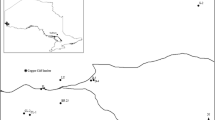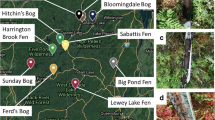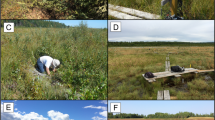Abstract
Peatlands subjected to sulfate deposition have been shown to produce less methane, believed to be due to competitive exclusion of methanogenic archaea by sulfate-reducing bacteria. Here, we address whether sulfate deposition produces impacts on a higher microbial group, the testate amoebae. Sodium sulfate was applied to experimental plots on a Scottish peatland and samples extracted after a period of more than 10 years. Impacts on testate amoebae were tested using redundancy analysis and Mann–Whitney tests. Results showed statistically significant impacts on amoebae communities particularly noted by decreased abundance of Trinema lineare, Corythion dubium, and Euglypha rotunda. As the species most reduced in abundance are all small bacterivores we suggest that our results support the hypothesis of a shift in dominant prokaryotes, although other explanations are possible. Our results demonstrate the sensitivity of peatland microbial communities to sulfate deposition and suggest sulfate may be a potentially important secondary control on testate amoebae communities.



Similar content being viewed by others
References
Booth RK (2002) Testate amoebae as paleoindicators of surface-moisture changes on Michigan peatlands: modern ecology and hydrological calibration. J Paleolimnol 28:129–348
Charriere F, Pavillon N, Colomb T, Depeursinge C, Heger TJ, Mitchell EAD, Marquet P, Rappaz B (2006) Living specimen tomography by digital holographic microscopy: morphometry of testate amoeba. Optics Express 14:7005–7013
Charman DJ (2001) Biostratigraphic and palaeoenvironmental applications of testate amoebae. Quat Sci Rev 20:1753–1764
Charman DJ, Hendon D, Woodland W (2000) The identification of testate amoebae (Protozoa: Rhizopoda) in peats. Quaternary Research Association Technical Guide Series, Cambridge
Charman DJ, Roe HM, Gehrels WR (2002) Modern distribution of saltmarsh testate amoebae: regional variability of zonation and response to environmental variables. J Quat Sci 17:387–409
Coûteaux M-M (1984) Relationships between testate amoeba and fungi in humus microcosms. Soil Biol Biochem 17:339–345
Dwyer RB, Mitchell FJG (1997) Investigation of the environmental impact of remote volcanic activity on north Mayo, Ireland, during the mid-Holocene. Holocene 7:113–118
Gauci V, Chapman SJ (2006) Simultaneous inhibition of CH4 efflux and stimulation of sulphate reduction in peat subject to simulated acid rain. Soil Biol Biochem 38:3506–3510
Gauci V, Dise N, Fowler D (2002) Controls on suppression of methane flux from a peat bog subjected to simulated acid rain sulfate deposition. Glob Biogeochem Cycles 16:1004
Gauci V, Matthews E, Dise N, Walter B, Koch D, Granberg G, Vile M (2004) Sulfur pollution suppression of the wetland methane source in the 20th and 21st centuries. Proc Natl Acad Sci U S A 101:12583–12587
Gauci V, Dise N, Blake S (2005) Long-term suppression of wetland methane flux following a pulse of simulated acid rain. Geophys Res Lett 32:L12804
Gauci V, Blake S, Stevenson DS, Highwood EJ (2008) Halving of the northern wetland CH4 source by a large Icelandic volcanic eruption. J Geophys Res 113:G00A11
Gilbert D, Amblard C, Bourdier G, Francez A (1998) The microbial loop at the surface of a peatland: structure, functioning and impact of nutrients inputs. Microb Ecol 35:83–93
Gilbert D, Amblard C, Bourdier G, Francez AJ (1998) Short-term effect of nitrogen enrichment on the microbial communities of a peatland. Hydrobiologia 373(374):111–119
Gilbert D, Amblard C, Bourdier G, Francez A-J, Mitchell EAD (2000) Le regime alimentaire des Thécamoebiens (Protista, Sarcodina). Année Biol 39:57–68
Gilbert D, Mitchell E, Amblard C, Bourdier G, Francez A-J (2003) Population dynamics and food preferences of the testate amoeba Nebela tincta major-bohemica-collaris complex (Protozoa) in a Sphagnum peatland. Acta Protozool 42:99–104
Hammer Ø, Harper DAT, Ryan PD (2001) PAST: Paleontological Statistics Software Package for Education and Data Analysis. Palaeontol Electron 4. http://palaeo-electronica.org/2001_1/past/issue1_01.htm
Han B-P, Wang T, Lin Q-Q, Dumont HJ (2008) Carnivory and active hunting by the planktonic testate amoeba Difflugia tuberspinifera. Hydrobiologia 596:197–201
Hendon D, Charman DJ (1997) The preparation of testate amoebae (Protozoa: Rhizopoda) samples from peat. Holocene 7:199–205
Inoue J-I, Noda S, Hongoh Y, Ui S, Ohkuma M (2008) Identification of endosymbiotic methanogen and ectosymbiotic spirochetes of gut protists of the termite Coptotermes formosanus. Microbes Environ 23:94–97
Krashevska V, Bonkowski M, Maraun M, Ruess L, Kandeler E, Scheu S (2008) Microorganisms as driving factors for the community structure of testate amoebae along an altitudinal transect in tropical mountain rain forests. Soil Biol Biochem 40:2427–2433
Lamentowicz L, Lamentowicz M, Gabka M (2008) Testate amoebae ecology and a local transfer function from a peatland in western Poland. Wetlands 28:164–175
Legendre P, Gallagher ED (2001) Ecologically meaningful transformations for ordination of species data. Oecologia 129:271–280
Mitchell EAD (2004) Response of testate amoebae (Protozoa) to N and P fertilization in an Arctic wet sedge tundra. Arct Antarct Alp Res 36:77–82
Mitchell EAD, Borcard D, Buttler A, Grosvernier P, Gilbert D, Gobat J-M (2000) Horizontal distribution patterns of testate amoebae (Protozoa) in a Sphagnum magellanicum carpet. Microb Ecol 39:290–300
Mitchell EAD, Buttler A, Grosvernier P, Rydin H, Albinsson C, Greenup AL, Heijmans MMPD, Hoosbeek MR, Saarinen T (2000) Relationships among testate amoebae (Protozoa), vegetation and water chemistry in five Sphagnum-dominated peatlands in Europe. New Phytol 145:95–106
Mitchell EAD, Gilbert D, Buttler A, Grosvernier P, Amblard C, Gobat J-M (2003) Structure of microbial communities in Sphagnum peatlands and effect of atmospheric carbon dioxide enrichment. Microb Ecol 16:187–199
Mitchell EAD, Charman DJ, Warner BG (2008) Testate amoebae analysis in ecological and paleoecological studies of wetlands: past, present and future. Biodivers Conserv 17:2115–2137
Murase J, Frenzel P (2008) Selective grazing of methanotrophs by protozoa in a rice field soil. FEMS Microbiol Ecol 65:408–414
Murase J, Noll M, Frenzel P (2006) Impact of protists on the activity and structure of the bacterial community in a rice field soil. Appl Environ Microbiol 72:5436–5444
Nedwell DB, Watson A (1995) CH4 production, oxidation and emission in a UK ombrotrophic peat bog: influence of SO 2−4 from acid rain. Soil Biol Biochem 27:893–903
Nishibe Y, Manage P, Kawabata Z, Nakano S (2004) Trophic coupling of a testate amoeba and Microcystis species in a hypertrophic pond. Limnology 5:71–76
Opravilova V, Hajek M (2006) The variation of testacean assemblages (Rhizopoda) along the complete base-richness gradient in fens: a case study from the Western Carpathians. Acta Protozool 35:191–204
Payne RJ, Mitchell EAD (2007) Ecology of testate amoebae from mires in the Central Rhodope Mountains, Greece and development of a transfer function for paleohydrological reconstruction. Protist 158:159–171
Payne RJ, Mitchell EAD (2009) How many is enough? Determining adequate count totals for ecological and palaeoecological studies of testate amoebae. J Paleolimnol (in press)
Payne RJ, Blackford JJ (2008) Volcanic impacts on peatlands: Palaeoecological evidence from Alaska. Quat Sci Rev 27:2012–2030
Rao CR (1995) A review of canonical coordinates and an alternative to correspondence analysis using Hellinger distance. Qüestiió 19:23–63
Schwarz MVJ, Frenzel P (2005) Methanogenic symbionts of anaerobic ciliates and their contribution to methanogenesis in an anoxic rice field soil. FEMS Microbiol Ecol 52:93–99
Stockmarr J (1971) Tablets with spores used in absolute pollen analysis. Pollen Spores 13:615–621
Ter Braak C, Šmilauer P (1997-2004) CANOCO for Windows. Biometris-Plant Research, The Netherlands
Tokura M, Ohkuma M, Kudo T (2000) Molecular phylogeny of methanogens associated with flagellated protists in the gut and with the gut epithelium of termites. FEMS Microbiol Ecol 33:233–240
Tolonen K, Warner B, Vasander H (1994) Ecology of testaceans (Protozoa: Rhizopoda) in mires in Southern Finland: II multivariate analysis. Archiv Protistenkund 144:97–112
Vickery E (2006) Monitoring ombrotrophic peatland damage and restoration using protozoa as indicator organisms. PhD thesis, University of Plymouth, Plymouth, UK
Vickery E, Charman DJ (2004) Biomonitoring of peatland restoration using testate amoebae. In: Verhoeven JTA, Dorland E, Coemans M (eds) 7th INTECOL international wetlands conference, vol. Book of abstracts, Utrecht, The Netherlands, 25–30 July 2004
Warner BG (1990) Testate amoebae (Protozoa). Methods in quaternary ecology. Geoscience, Canada 5, Geological Association of Canada, pp. 65–74
Watson A, Nedwell DB (1998) Methane production and emission from peat: the influence of anions (sulphate, nitrate) from acid rain. Atmos Environ 32:3239–3245
Weijers JWH, Schouten S, van der Linden M, van Geel B, Sinninghe Damst JS (2004) Water table related variations in the abundance of intact archaeal membrane lipids in a Swedish peat bog. FEMS Microbiol Lett 239:51–56
Weisse T, Muller H, Pinto-Coelho RM, Schweizer A, Springmann D, Baldringer G (1990) Response of the microbial loop to the phytoplankton spring bloom in a large prealpine lake. Limnol Oceanogr 35:781–794
Woodland W, Charman D, Simms P (1998) Quantitative estimates of water tables and soil moisture in Holocene peatlands from testate amoebae. Holocene 8:261–273
Yeates GW, Foissner W (1995) Testate amoebae as predators of nematodes. Biol Fertil Soils 20:1–7
Acknowledgements
RJP was supported by a Humanities Research Fellowship from the University of Manchester. Fieldwork was funded by the University of Manchester. Thanks to Moray Estates and Scottish Natural Heritage for permission to work on Moidach More. Figure 1 was drawn by Graham Bowden. Comments from three anonymous reviewers helped improve the paper.
Author information
Authors and Affiliations
Corresponding author
Rights and permissions
About this article
Cite this article
Payne, R., Gauci, V. & Charman, D.J. The Impact of Simulated Sulfate Deposition on Peatland Testate Amoebae. Microb Ecol 59, 76–83 (2010). https://doi.org/10.1007/s00248-009-9552-6
Received:
Accepted:
Published:
Issue Date:
DOI: https://doi.org/10.1007/s00248-009-9552-6




